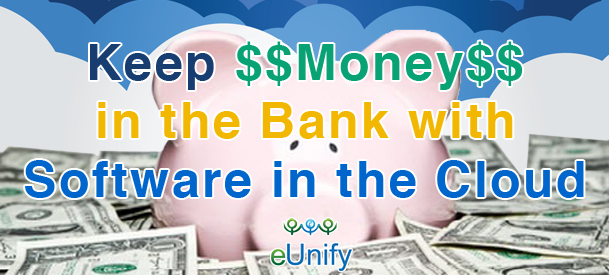
When it comes to technology and selecting software providers, it is extremely important to consider the cost of software. Equally important is assessing the true IT costs of your operation. Shopping for software comes with some degree of sticker shock, but if software can offset other IT costs, it might be well worth updating your budget and maybe earning a few extra rewards points/miles on your credit card. Let’s consider one key “must-have” when it comes to choosing software and ensuring a quicker return on investment: Cloud-computing. Below is a quick rundown on what it means to be “in the cloud” and why it is so critical in terms of cost-savings, and adding true value to your business.
What is the Cloud?
This term has come to refer to the growing trend of running applications and storing data offsite, in commercial servers. Think of this as outsourced computing. With internet connection speeds increasing all the time, it has become practical, and even preferable to store our photos, documents, and even business books in the cloud. More and more software providers are hosting their systems in the cloud, as well, which means you can access many of the tools you need to run your personal life and business simply with a good internet connection.
Why the Cloud?
Convenience: The outsourced nature of cloud-computing offers the advantage of “letting someone else do it” when it comes to disaster preparedness, backups, server maintenance, security, and system updates. Another benefit is anytime/anywhere access to your applications and files. Being in the cloud allows you to carry your business with you wherever you go, which some might not consider a benefit, but the reality of today’s business world requires this in order for you to be competitive.
Cost-Savings: If you go with software that requires local installation on each of your office computers, or that requires use of an office server, the costs to your business and its productivity could really add up. Here is a list of expensive items you will have to budget for without a cloud-based software system:
- Hardware/Server and backup power supplies:If all the software you use is cloud-based, you might not even need an in-house server, which could save tens of thousands of dollars in hardware costs.
- Beefed up Network: Faster connection with full redundancy will be needed to cover internal and external network traffic.
- IT Personnel/Consulting Fees: Whether you hire someone to maintain your network or contract a local IT firm, you could be spending hundreds or thousands of dollars a month to maintain your server and network(s). You will need IT support to assist with backups, disaster recovery, and security as well. Cloud-based software offers all of this critical maintenance, built in. Just be sure to find a software provider that guarantees the routine backup and security of your data.
- Software Licenses: Software titles that require local installation carry licensing fees upfront, sometimes ongoing fees, and even fees for applying new updates, as well. With cloud-based software, updates are typically universally applied at no added expense or inconvenience to you.
- OS Licenses: You will also have to pay for licenses to run the appropriate operating system on your server, such as Linux RedHat, SQL Server, MS Server (Windows).
Conclusion:
When you shop for software, be sure to honestly assess what your true costs are. On the surface, a new software platform might be expensive, but if it saves you from buying and maintaining an expensive server, or reduces your need for external IT consultation, or offers security, backups, and convenient mobile access to your business, it really could be paying for itself almost immediately.
